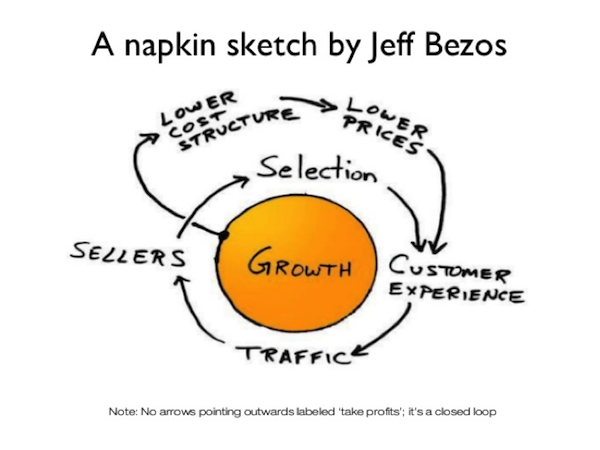Sometimes it seems that Amazon doesn’t support sellers in its marketplace. Seemingly nonstop restrictions on what can be sold in each category make it difficult for some sellers to list products. Violations and suspensions for minor infractions make sellers believe that Amazon is putting up barriers to success.
Actually, Amazon does want you to succeed. Marketplace sellers are significant to Amazon’s overall growth. Third-party sellers represent about 50 percent of all sales on Amazon.com. Sellers also provide Amazon with its breadth of selection. However, sellers should understand Amazon’s relentless pursuit of customer satisfaction.
The famous Bezos napkin sketch
Jeff Bezos, Amazon’s founder, had a simple vision for the company. A low cost structure would lead to lower prices. Lower prices with a wide range of products would lead to a better customer experience. This creates higher retention of satisfied customers, who return to make further purchases. This retention leads to continually increasing traffic to the website. Increasing traffic will attract more sellers, who will expand the selection. Combined, these factors lead to accelerated growth.
Bezos illustrated this vision in his now-famous napkin sketch.

Jeff Bezos’s famous napkin sketch outlined the strategy for Amazon.
How has this napkin strategy worked out? Amazon averages over 6.5 million site visits per day. That makes Amazon the 10th largest website in the world by visits and the largest ecommerce site, according to Alexa statistics.
There’s one major item that is absent from Bezos’s napkin sketch: no taking of profits. What this strategy shows, and what most analysts misunderstand, is that reinvesting the profits back into the company creates a stronger brand.
Aligning with Amazon’s strategy
Once sellers understand Amazon’s strategy, they can begin to understand Amazon’s decisions. As a seller, you want Amazon to be diligent in policing the marketplace. It would not be good for consumers if the marketplace had no clear standards. It’s those standards that help sellers.
Providing a compelling and optimized listing will lead to more sales. When the sales of a product increase, that product will rank higher. A higher ranking gives the product a better placement. Better placement leads to more sales. More sales lead to a higher ranking, which provides better placement. And so on.
Seller Labs, which provides excellent tools for Amazon sellers, has created a helpful illustration of how Amazon sellers can offer a compelling customer experience.

SellerLabs’ illustration shows how Amazon sellers can offer a compelling customer experience.
Similar to Google, a quality score is critical to Amazon. Although there is no stated grade as there is with Google, we know what components affect your listings.
Amazon’s algorithm looks for these items:
- Between six and 10 high-quality images.
- Product title. Depending on the category, product titles can range from 50 to 250 characters.
- A strong brand.
- Optimized bullet points. Shoppers don’t buy features, they buy benefits. State the features and describe the benefits.
- A keyword-rich product description of at least 1,000 characters
- Backend keywords. In the admin section of a user’s seller account, provide Amazon with additional information about a listing.
- Backend target market, intended use, and other attributes.
All of these fields help Amazon deliver the best product result for a search query.
Your seller performance also affects your rankings on Amazon. An unsatisfactory performance rating — i.e., bad reviews, frequent out-of-stock items — will hurt your rankings.
Seller feedback score
The following factors determine a seller’s feedback score on Amazon.
- Conversion rate. Calculated as (Total Items Ordered) / (Number of Sessions). The higher conversion rate, the more relevant the product.
- Product reviews. A product below a 3.6 average rating is ineligible for lightning deals and other advertising considerations.
- Sales velocity. The number of units sold.
- Inventory and fulfillment. Ability to keep items in stock; speed of delivery.
- Historical sales. Sustained sales over time.
Understanding discovery
It’s important to remember that Google is mainly a search engine for answering questions, while Amazon is mainly a search engine for finding products.
Fifty-seven percent of shoppers on Amazon know what they want before they make a purchase. Fourteen percent of shoppers are replenishing products. This leaves twenty-nine percent of shoppers who are browsing on the site, to discover new items. Twenty-nine percent of 6.5 million daily visitors is a large number of prospects.
There are two important takeaways. First, advertising on “Sponsored Products Related To This Item” can help shoppers find your items. This ad is triggered by keywords associated with the product listing on that page. So, knowing your competitor and your competitor’s keyword sets is vital to driving sales from Sponsored Products ads.
Second, what you do off of the Amazon marketplace to promote your products directly correlates to success on Amazon. Driving traffic from social media and from Amazon affiliate sites is something you should always consider, as Amazon monitors inbound traffic to a product as a measure of its popularity.


